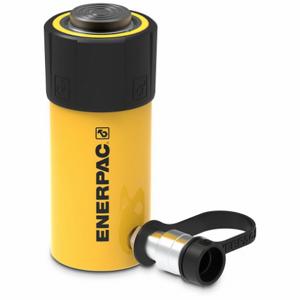Enerpac RC254 hydraulic cylinder is used in the construction, manufacturing, oil and gas, mining, transportation & logistics and maintenance & repair industries for heavy lifting and pushing applications. It offers exceptional durability, versatility and productivity, making it an excellent choice for demanding tasks.
Features:
- It features a bearing system with composite wear bands for optimal sideload resistance.
- This hydraulic cylinder comes with a strengthened stop ring that enhances durability and side load resistance.
- It is equipped with the Trio Hybrid pre-tensioned spring system, enabling faster retraction.
- This hydraulic cylinder offers high-grade polyethylene seals that ensure low wear and long service life.
- It has a plunger wiper that reduces contamination, extending the cylinder's lifespan.
- This hydraulic cylinder is integrated with collar and plunger threads, along with base mounting holes, enabling easy fixturing on most models.
- It offers baked enamel finish for increased corrosion resistance.
Compatible Accessories:
- Enerpac CR400 Hydraulic Coupler: This RC254 hydraulic cylinder is a socket half of a quick-disconnect hydraulic coupler. The brand's CR400 hydraulic coupler is compatible with this cylinder, allowing quick and easy connection to or disconnection from hydraulic tools.
Frequently Asked Questions:
Q. How do I install this Enerpac RC-254 hydraulic cylinder?
A.
- Position the cylinder in the desired location for installation.
- Align the collar and plunger threads of the cylinder with the corresponding mating threads on the equipment or mounting surface.
- Securely tighten the collar and plunger threads to ensure a secure connection.
- Use base mounting holes to attach the cylinder to the equipment or mounting surface, if applicable.
- Connect hydraulic hoses or fittings from the hydraulic power source to the cylinder's hydraulic ports.
- Ensure proper alignment and tight connections of hydraulic hoses or fittings.
Q. What are the factors to consider while choosing a hydraulic cylinder?
A.
- Load capacity
- Stroke length
- Operating pressure
- Speed requirements
- Mounting options
- Environmental conditions
- Maintenance and serviceability
- Budget and cost-effectiveness
Q. How do I clean and maintain this hydraulic cylinder?
A.
- Perform regular visual inspections for leaks, damage or signs of wear.
- Remove dirt, debris and contaminants using a clean cloth or brush.
- Monitor and replace worn or damaged seals to prevent hydraulic fluid leaks.
- Apply appropriate lubrication to moving parts as per manufacturer recommendations.
- Regularly check and replace hydraulic fluid according to the manufacturer's guidelines.
- Clean or replace hydraulic filters to ensure proper fluid cleanliness.
- Follow recommended maintenance schedules and procedures provided by the manufacturer.
- Consult a qualified technician or service centre for more complex maintenance or repairs, if needed.









